DRAFT! c January 7, 1999 Christopher Manning & Hinrich Schütze.
293
9 Markov Models
HIDDEN MARKOV MODEL
MARKOV MODEL
H I D D E N M A R K O V M O D E L S (HMMs) have been the mainstay of the
statistical modeling used in modern speech recognition systems. Despite
their limitations, variants of HMMs are still the most widely used tech-
nique in that domain, and are generally regarded as the most successful. In
this chapter we will develop the basic theory of HMMs, touch on their ap-
plications, and conclude with some pointers on extending the basic HMM
model and engineering practical implementations.
An HMM is nothing more than a probabilistic function of a Markov pro-
cess. We have already seen an example of Markov processes in the n-gram
models of Chapters 2 and 6. Markov processes/chains/models were first devel-
oped by Andrei A. Markov (a student of Chebyshev). Their first use was
actually for a linguistic purpose – modeling the letter sequences in works
of Russian literature (Markov 1913) – but Markov models were then devel-
oped as a general statistical tool. We will refer to vanilla Markov models as
Visible Markov Models (VMMs) when we want to be careful to distinguish
them from HMMs.
We have placed this chapter at the beginning of the “grammar” part of
the book because working on the order of words in sentences is a start at
understanding their syntax. We will see that this is what a VMM does.
HMMs operate at a higher level of abstraction by postulating additional
“hidden” structure, and that allows us to look at the order of categories of
words. After developing the theory of HMMs in this chapter, we look at
the application of HMMs to part-of-speech tagging. The last two chapters
in this part then deal with the probabilistic formalization of core notions of
grammar like phrase structure.
�
294
9 Markov Models
9.1 Markov Models
Often we want to consider a sequence (perhaps through time) of random
variables that aren’t independent, but rather the value of each variable de-
pends on previous elements in the sequence. For many such systems, it
seems reasonable to assume that all we need to predict the future random
variables is the value of the present random variable, and we don’t need
to know the values of all the past random variables in the sequence. For
example, if the random variables measure the number of books in the uni-
versity library, then, knowing how many books were in the library today
might be an adequate predictor of how many books there will be tomor-
row, and we don’t really need to additionally know how many books the
library had last week, let alone last year. That is, future elements of the se-
quence are conditionally independent of past elements, given the present
element.
Suppose X X� XT is a sequence of random variables taking
values in some finite set S = fs� sN g, the state space. Then the Markov
Properties are:
MARKOV ASSUMPTION
Limited Horizon:
(9.1)
(9.2)
P Xt� skjX� Xt P Xt� skjXt
Time invariant (stationary):
P X� skjX�
X is then said to be a Markov chain, or to have the Markov property.
One can describe a Markov chain by a stochastic transition matrix A:
(9.3)
aij P Xt� sjjXt si
Here, aij � �i j and PN
Additionally one needs to specify , the probabilities of different initial
states for the Markov chain:
j� aij � �i.
(9.4)
i P X� si
Here, PN
i� i �. The need for this vector can be avoided by specifying
that the Markov model always starts off in a certain extra initial state, s�,
and then using transitions from that state contained within the matrix A to
specify the probabilities that used to be recorded in .
�
9.1 Markov Models
295
��
h
e
��
a
��
��
��
t
start
��
p
��
i
��
��
��
Figure 9.1 A Markov model.
From this general description, it should be clear that the word n-gram
models we saw in Chapter 6 are Markov models. Markov models can be
used whenever one wants to model the probability of a linear sequence of
events. For example, they have also been used in NLP for modeling valid
phone sequences in speech recognition, and for sequences of speech acts
in dialog systems.
Alternatively, one can represent a Markov chain by a state diagram as
in Figure 9.1. Here, the states are shown as circles around the state name,
and the single start state is indicated with an incoming arrow. Possible
transitions are shown by arrows connecting states, and these arcs are la-
beled with the probability of this transition being followed, given that you
are in the state at the tail of the arrow. Transitions with zero probability
are omitted from the diagram. Note that the probabilities of the outgoing
arcs from each state sum to 1. From this representation, it should be clear
that a Markov model can be thought of as a (nondeterministic) finite state
automaton with probabilities attached to each arc. The Markov properties
ensure that we have a finite state automaton. There are no long distance
dependencies, and where one ends up next depends simply on what state
one is in.
In a visible Markov model, we know what states the machine is passing
through, so the state sequence or some deterministic function of it can be
regarded as the output.
The probability of a sequence of states (that is, a sequence of random
�
296
9 Markov Models
variables) X� XT is easily calculated for a Markov chain. We find that
we need merely calculate the product of the probabilities that occur on the
arcs or in the stochastic matrix:
P X� XT P X�P X�jX�P X�jX� X� P XT jX� XT �
P X�P X�jX�P X�jX� P XT jXT �
X�
T �Y
t�
aXtXt�
So, using the Markov model in Figure 9.1, we have:
P t i p P X� tP X� ijX� tP X� pjX� i
�� �� ��
���
Note that what is important is whether we can encode a process as a
Markov process, not whether we most naturally do. For example, recall
the n-gram word models that we saw in Chapter 6. One might think that,
for n �, such a model is not a Markov model because it violates the Lim-
ited Horizon condition – we are looking a little into earlier history. But
we can reformulate any n-gram model as a visible Markov model by sim-
ply encoding the appropriate amount of history into the state space (states
are then n �-grams, for example (was, walking, down) would be a state
in a fourgram model). In general, any fixed finite amount of history can
always be encoded in this way by simply elaborating the state space as a
crossproduct of multiple previous states. In such cases, we sometimes talk
of an mth order Markov model, where m is the number of previous states
that we are using to predict the next state. Note, thus, that an n-gram
model is equivalent to an n �th order Markov model.
Exercise 9-1
Build a Markov Model similar to Figure 9.1 for one of the types of phone numbers
in Table 4.2.
9.2 Hidden Markov Models
In an HMM, you don’t know the state sequence that the model passes
through, but only some probabilistic function of it.
�
9.2 Hidden Markov Models
297
0.7
Cola
Pref.
0.3
0.5
start
Iced Tea
Pref.
0.5
Figure 9.2 The crazy soft drink machine, showing the states of the machine and
the state transition probabilities.
Suppose you have a crazy soft drink machine: it can be in
Example 1:
two states, cola preferring (CP) and iced tea preferring (IP), but it switches
between them randomly after each purchase, as shown in Figure 1.
Now, if, when you put in your coin, the machine always put out a cola if
it was in the cola preferring state and an iced tea when it was in the iced tea
preferring state, then we would have a visible Markov model. But instead,
it only has a tendency to do this. So we need symbol emission probabilities
for the observations:
P Ot kjXt si Xt� sj bijk
For this machine, the output is actually independent of sj, and so can be
described by the following probability matrix:
Output probability given From state
cola
iced tea
lemonade
CP
IP
0.6
0.1
ice_t
0.1
0.7
lem
0.3
0.2
What is the probability of seeing the output sequence {lem, ice_t} if the
machine always starts off in the cola preferring state?
Solution: We need to consider all paths that might be taken through the
HMM, and then to sum over them. We know the machine starts in state
CP. There are then four possibilities depending on which of the two states
the machine is in at the other two time instants. So the total probability is:
�� �� �� �� �� �� �� ��
�� �� �� �� �� �� �� �� ����
�
298
9 Markov Models
Exercise 9-2
What is the probability of seeing the output sequence {col,lem } if the machine al-
ways starts off in the ice tea preferring state?
9.2.1 Why use HMMs?
HMMs are useful when one can think of underlying events probabilisti-
cally generating surface events. One widespread use of this is tagging –
assigning parts of speech (or other classifiers) to the words in a text. We
think of there being an underlying Markov chain of parts of speech from
which the actual words of the text are generated. Such models are dis-
cussed in Chapter 10.
When this general model is suitable, the further reason that HMMs are
very useful is that they are one of a class of models for which there exist
efficient methods of training through use of the Expectation Maximization
(EM) algorithm. Given plenty of data that we assume to be generated by
some HMM – where the model architecture is fixed but not the probabilities
on the arcs – this algorithm allows us to automatically learn the model
parameters that best account for the observed data.
Another simple illustration of how we can use HMMs is in generating
parameters for linear interpolation of n-gram models. We discussed in
Chapter 6 that one way to estimate the probability of a sentence:
P Sue drank her beer before the meal arrived
was with an n-gram model, such as a trigram model, but that just using
an n-gram model with fixed n tended to suffer because of data sparseness.
Recall from Section 6.3.1 that one idea of how to smooth n-gram estimates
was to use linear interpolation of n-gram estimates for various n, for ex-
ample:
P liwnjwn� wn� �P�wn �P�wnjwn� �P�wnjwn� wn�
This way we would get some idea of how likely a particular word was,
even if our coverage of trigrams is sparse. The question, then, is how to
set the parameters i. While we could make reasonable guesses as to what
parameter values to use (and we know that together they must obey the
stochastic constraintPi i �), it seems that we should be able to find the
optimal values automatically. And, indeed, we can (Jelinek 1990).
The key insight is that we can build an HMM with hidden states that rep-
resent the choice of whether to use the unigram, bigram, or trigram prob-
abilities. The HMM training algorithm will determine the optimal weight
�
9.2 Hidden Markov Models
299
w�P�w�
�ab
�
�
wawb
�ab
w�
P
�w�
b
j w
�
w
w�P�w�jwb
w
� P �
w
� P
�
w
wbw�
b
a w
� jw
wbw�
w
M
P
wM
P
�wM
�
w
�
jwb
b
w
a
j w
�
w
� P
�
w
wM P�wM jwawb
�ab
M
wbwM
Figure 9.3 A section of an HMM for a linearly interpolated language model. The
notation o p on arcs means that this transition is made with probability p, and that
an o is output when this transition is made (with probability 1).
to give to the arcs entering each of these hidden states, which in turn rep-
resents the amount of the probability mass that should be determined by
each n-gram model via setting the parameters i above.
Concretely, we build an HMM with four states for each word pair, one
for the basic word pair, and three representing each choice of n-gram model
for calculating the next transition. A fragment of the HMM is shown in Fig-
ure 9.3. Note how this HMM assigns the same probabilities as the earlier
equation: there are three ways for wc to follow wawb and the total probabil-
ity of seeing wc next is then the sum of each of the n-gram probabilities that
adorn the arcs multiplied by the corresponding parameter i. The HMM
training algorithm that we develop in this chapter can then be applied to
this network, and used to improve initial estimates for the parameters iab.
There are two things to note. This conversion works by adding epsilon tran-
sitions – that is transitions that we wish to say do not produce an output
symbol. Secondly, as presented, we now have separate parameters iab
for each word pair. But we would not want to adjust these parameters
separately, as this would make our sparse data problem worse not better.
Rather, for a fixed i, we wish to keep all (or at least classes of) the iab pa-
EPSILON TRANSITIONS
�
300
9 Markov Models
Set of states
Output alphabet
S fs� sN g
K fk� kM g f� M g
Intial state probabilities
State transition probabilities
Symbol emission probabilities B fbijkg i j � S k � K
fig i � S
A faijg i j � S
State sequence
Output sequence
X X� XT � Xt S � f� N g
O o� oT
ot � K
Table 9.1 Notation used in the HMM chapter.
rameters having the same value, which we do by using tied states. Discus-
sion of both of these extensions to the basic HMM model will be deferred
to Section 9.4.
9.2.2 General form of an HMM
ARC-EMISSION HMM
STATE-EMISSION HMM
An HMM is specified by a five-tuple (S, K, , A, B), where S and K are the
set of states and the output alphabet, and , A, and B are the probabilities
for the initial state, state transitions, and symbol emissions, respectively.
The notation that we use in this chapter is summarized in Table 9.1. The
random variables Xt map from state names to corresponding integers. In
the version presented here, the symbol emitted at time t depends on both
the state at time t and at time t �. This is sometimes called a arc-emission
HMM, because we can think of the symbol as coming off the arc, as in
Figure 9.3. An alternative formulation is a state-emission HMM, where the
symbol emitted at time t depends just on the state at time t. The HMM in
Example 1 is a state-emission HMM. But we can also regard it as a arc-
emission HMM by simply setting up the bijk parameters so that �k� k��,
bijk� bijk�� . This is discussed further in Section 9.4.
Given a specification of an HMM, it is perfectly straightforward to simu-
late the running of a Markov process, and to produce an output sequence.
One can do it with the program in Figure 9.4. However, by itself, doing
this is not terribly interesting. The interest in HMMs comes from assuming
that some set of data was generated by a HMM, and then being able to
calculate probabilities and probable underlying state sequences.
�
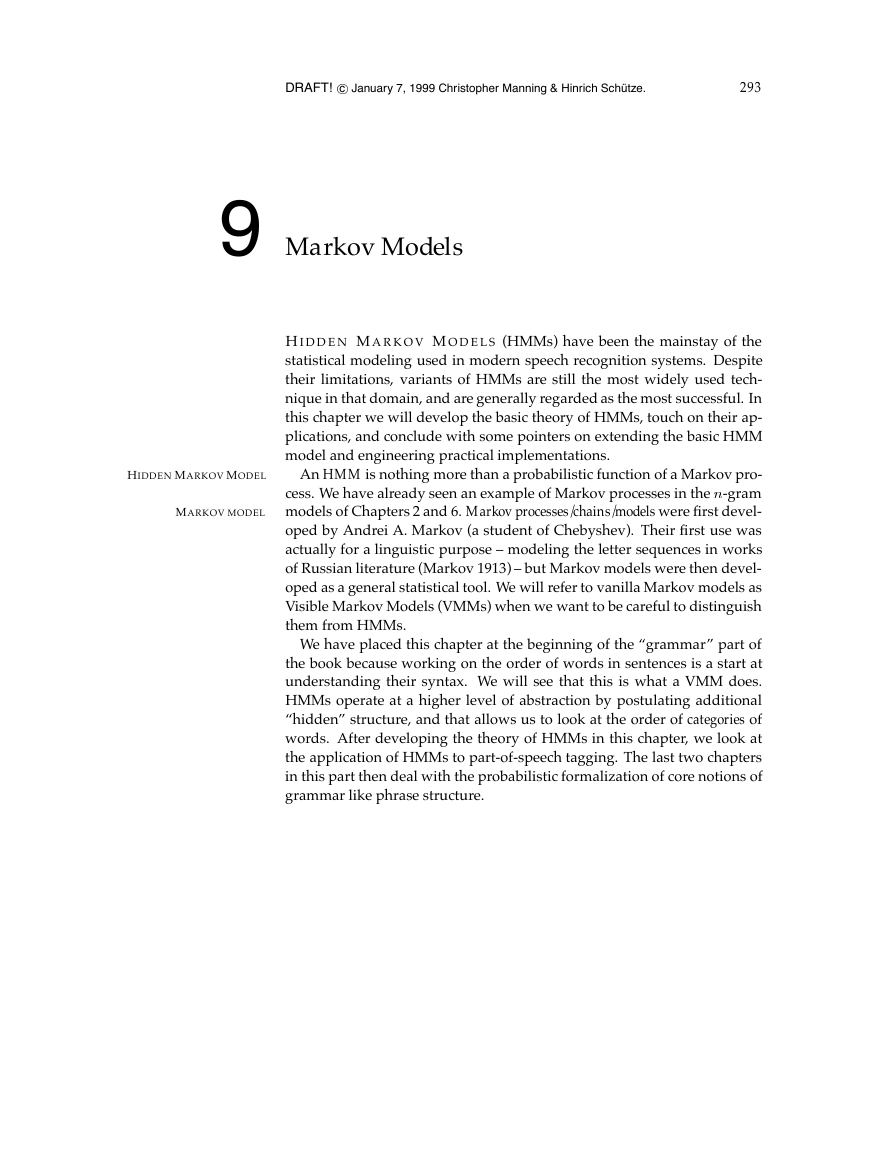
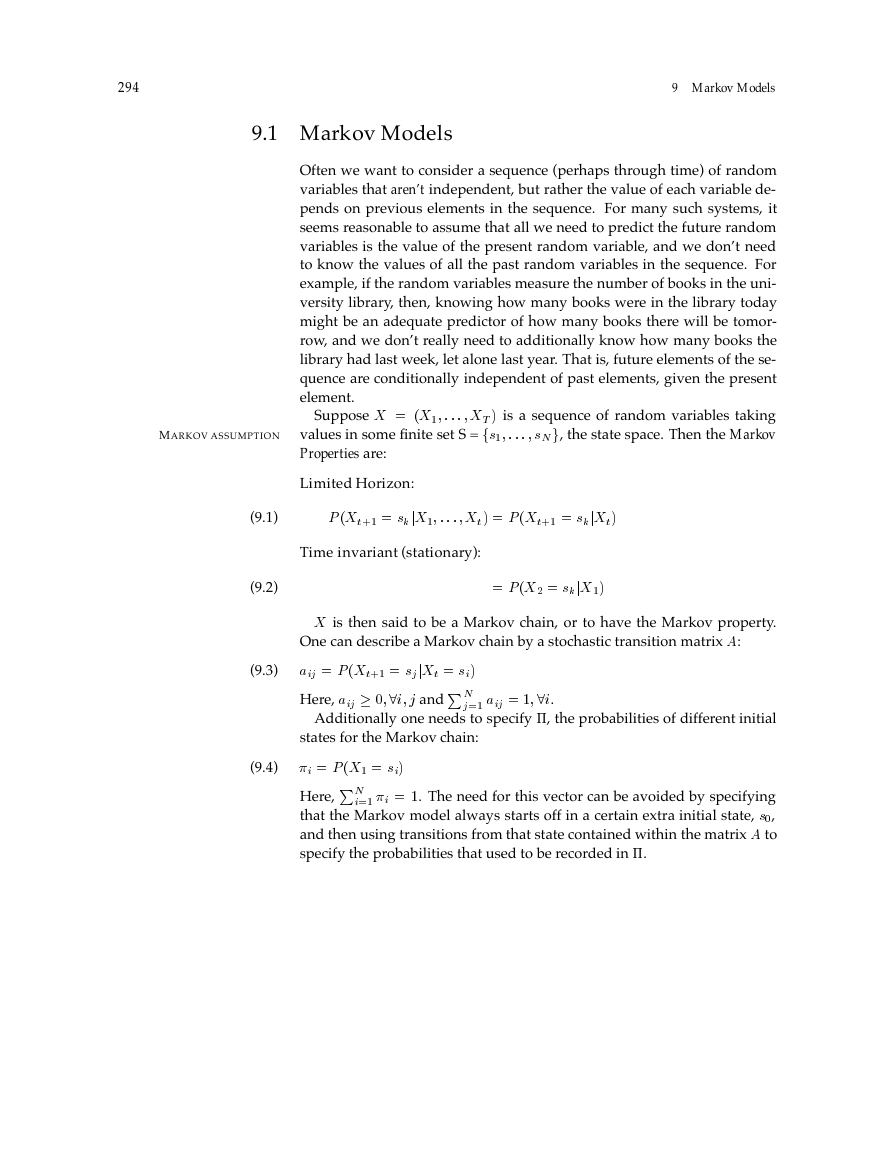


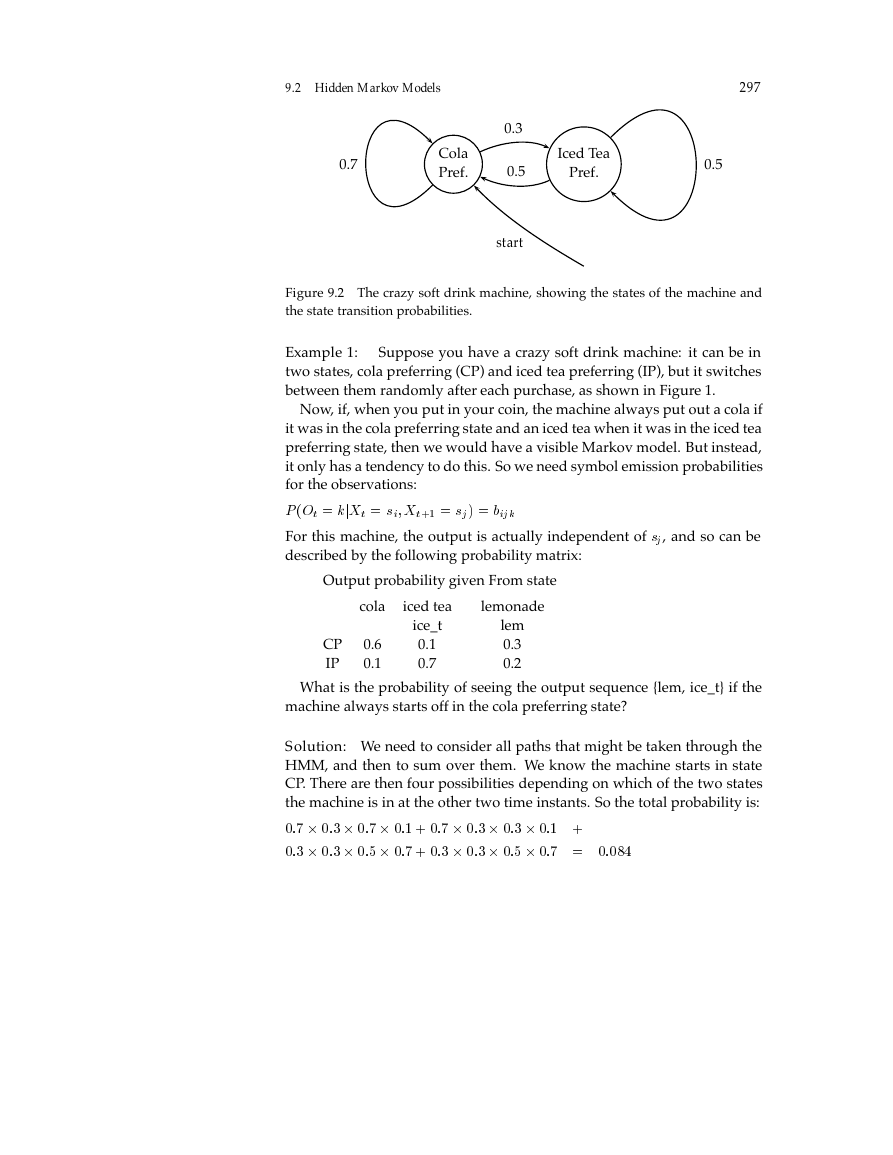
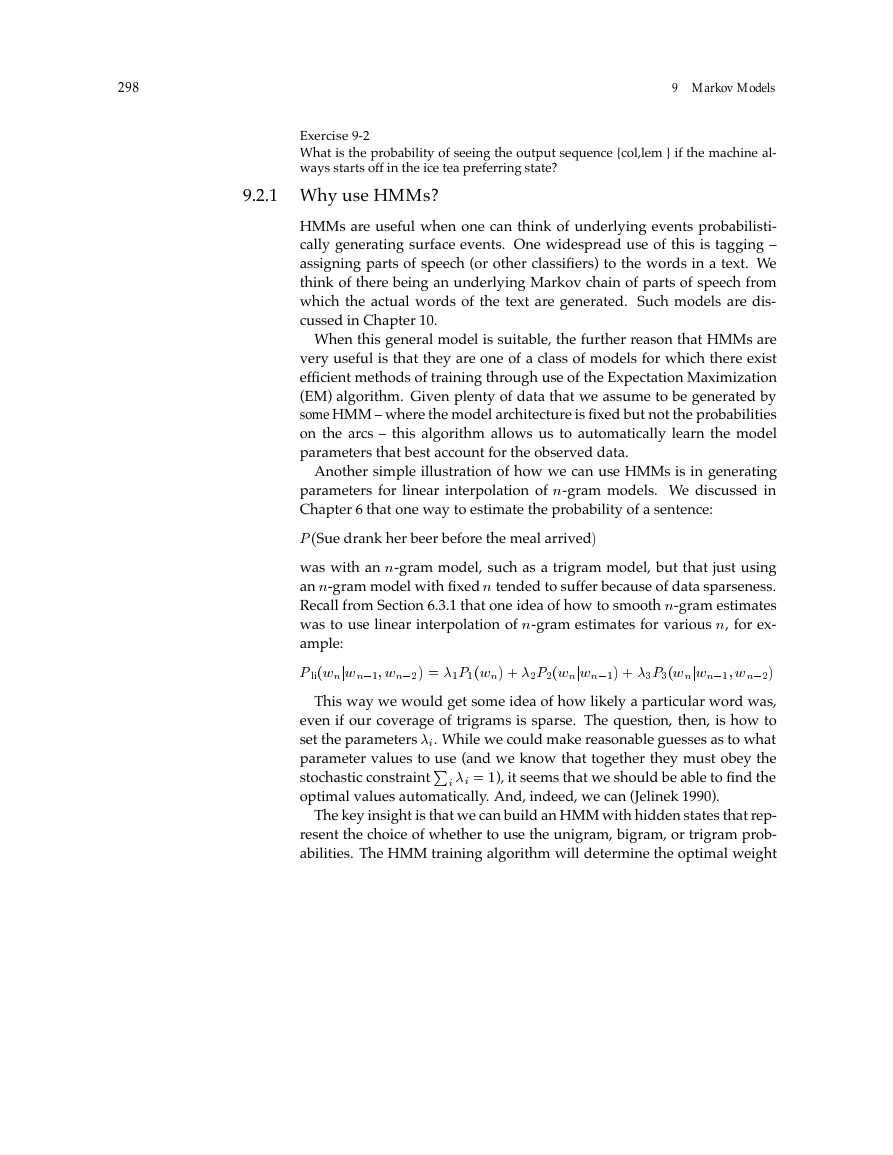
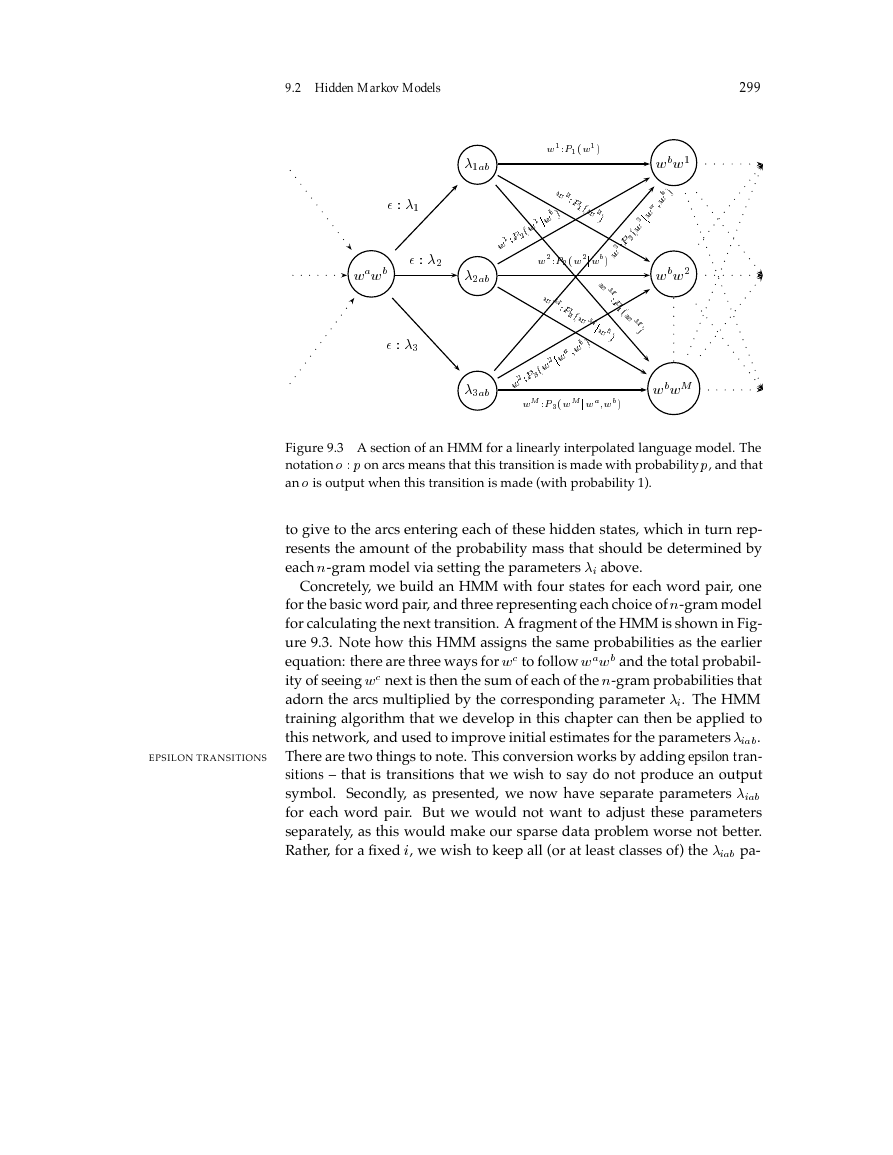









 2023年江西萍乡中考道德与法治真题及答案.doc
2023年江西萍乡中考道德与法治真题及答案.doc 2012年重庆南川中考生物真题及答案.doc
2012年重庆南川中考生物真题及答案.doc 2013年江西师范大学地理学综合及文艺理论基础考研真题.doc
2013年江西师范大学地理学综合及文艺理论基础考研真题.doc 2020年四川甘孜小升初语文真题及答案I卷.doc
2020年四川甘孜小升初语文真题及答案I卷.doc 2020年注册岩土工程师专业基础考试真题及答案.doc
2020年注册岩土工程师专业基础考试真题及答案.doc 2023-2024学年福建省厦门市九年级上学期数学月考试题及答案.doc
2023-2024学年福建省厦门市九年级上学期数学月考试题及答案.doc 2021-2022学年辽宁省沈阳市大东区九年级上学期语文期末试题及答案.doc
2021-2022学年辽宁省沈阳市大东区九年级上学期语文期末试题及答案.doc 2022-2023学年北京东城区初三第一学期物理期末试卷及答案.doc
2022-2023学年北京东城区初三第一学期物理期末试卷及答案.doc 2018上半年江西教师资格初中地理学科知识与教学能力真题及答案.doc
2018上半年江西教师资格初中地理学科知识与教学能力真题及答案.doc 2012年河北国家公务员申论考试真题及答案-省级.doc
2012年河北国家公务员申论考试真题及答案-省级.doc 2020-2021学年江苏省扬州市江都区邵樊片九年级上学期数学第一次质量检测试题及答案.doc
2020-2021学年江苏省扬州市江都区邵樊片九年级上学期数学第一次质量检测试题及答案.doc 2022下半年黑龙江教师资格证中学综合素质真题及答案.doc
2022下半年黑龙江教师资格证中学综合素质真题及答案.doc